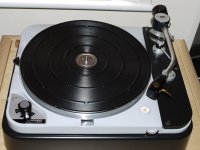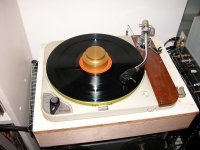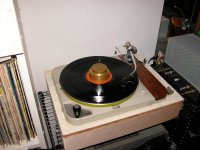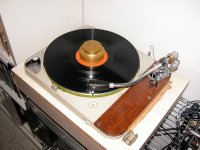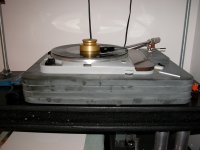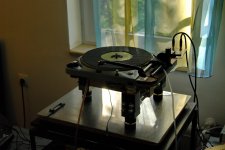Rebuilt the motor today and happy to report the table now runs on speed and has been doing so for several hours now. The table after reassembly just refused to run at full speed, it was just slightly slow no matter what I did - even disabling the eddy current brake didn't help. The problem was evident on all speeds - pointing to the motor.
This is a tight budget project for an acquaintance so where possible parts are being cleaned up and reused.
The last picture shows the victim apart and the rivets retaining the bearing housings have been drilled out.
The first and second picture show the original felts in soak cycle 3 of 5 in lacquer thinner, and when clean and dry. The felts looked and felt pretty good after their soak in lacquer thinner, they were pretty hard from the oil gummy oil prior to soaking. I dried them thoroughly before impregnating them with fresh oil
The third picture shows filthy oil oozing out of the bearings in my dedicated workshop oven after being heated to 300 degrees F (149 degrees C), this was followed by a quick soak in lacquer thinner. Once clean they were soaked in hot oil in the oven for 10 minutes and then allowed to cool.
The fourth picture shows the upper bearing housing sans large felt, but otherwise ready to be reinstalled.
Fifth picture is the lower housing , six with lower housing completed, and seven is the motor reassembled. Make sure the bearings are aligned properly prior to tightening things down and check for freedom of rotation and noise (powered on the bench) prior to installation if possible.
The next to last is the victim being run in. So far running on speed for a couple of hours.
This is a very interesting thread for DIYers and wish it had been around when I was contemplating what to do with my TD 124 Mk 2 around March 2011. Well being a bit impatient I bit the bullet and sent the TT to Schoppers for a total restoration. Well I thought if you're going to do it it will be only once in my lifetime!
Parts replaced:main bearing; sub/lower platter and upper platter; solid plinth and Swissonor TA10in tonearm.
End result: tremendous pace, rhythm, timing and deep controlled bass.WOW.And a substantially reduced wallet...
Was it worth it? You bet.
 The Schopper stuff is premium quality, and expensive, but these guys really know the TD-124 inside out, unlikely that anyone would do an update better..
The Schopper stuff is premium quality, and expensive, but these guys really know the TD-124 inside out, unlikely that anyone would do an update better.. I'm debating purchasing one of their non-magnetic cast iron platters, replacing the zamac platter that originally came with my table with a stock Thorens cast iron platter made a pretty significant improvement in terms of neutrality and lowered the overall noise floor significantly. (The zamac platter is extremely resonant, the iron platter considerably less so.) The cast iron platter does interact magnetically with my Meister Silver SPU which is something I probably would like to avoid.
The Schopper stuff is premium quality, and expensive, but these guys really know the TD-124 inside out, unlikely that anyone would do an update better..
I'm debating purchasing one of their non-magnetic cast iron platters, replacing the zamac platter that originally came with my table with a stock Thorens cast iron platter made a pretty significant improvement in terms of neutrality and lowered the overall noise floor significantly. (The zamac platter is extremely resonant, the iron platter considerably less so.) The cast iron platter does interact magnetically with my Meister Silver SPU which is something I probably would like to avoid.
I can thoroughly recommend the Schopper platter especially for use with SPUs. Its a little bit heavier I think than the Thorens cast iron platter and used with the upper platter too a superb combination. Noise levels have dropped considerably leaving you to listen only to the music.
Attachments
Today I scored a Thorens TD-124 parts unit which will allow me to restore full functionality to my second table as it has all of the parts I'm missing despite more than a year of fruitless searching the web.
I paid significantly more for this basket case than I did for my first TD-124/II which was minty. I hope eventually to defray some of the costs incurred by selling off duplicate parts.
Stay tuned, pictures and a blow by blow description of the surgery will follow once the donor unit gets here.
I paid significantly more for this basket case than I did for my first TD-124/II which was minty. I hope eventually to defray some of the costs incurred by selling off duplicate parts.
Stay tuned, pictures and a blow by blow description of the surgery will follow once the donor unit gets here.
I can thoroughly recommend the Schopper platter especially for use with SPUs. Its a little bit heavier I think than the Thorens cast iron platter and used with the upper platter too a superb combination. Noise levels have dropped considerably leaving you to listen only to the music.
This is good to hear, still on my list for eventual acquisition.
Good projects.
Just interjecting that #2729 still holding steady speed over here.
I've changed my cartridge from a wood bodied DL-103R (with SS ruby/FL tip) to a now refurbished Shelter 501-II. Tonearm is still the Zeta equipped with Incognito silver wire harness.
A nice step up from the Denon cartridge. And the Shelter seems to compliment the strong points of the Thorens, and perhaps the Thorens compliments the better qualities of the Shelter. A faster transient. Livelier. More ambient. Bass is tight yet energetic and slammy. Gets texture nicely in the lower frequencies.
-Steve
Just interjecting that #2729 still holding steady speed over here.
I've changed my cartridge from a wood bodied DL-103R (with SS ruby/FL tip) to a now refurbished Shelter 501-II. Tonearm is still the Zeta equipped with Incognito silver wire harness.
A nice step up from the Denon cartridge. And the Shelter seems to compliment the strong points of the Thorens, and perhaps the Thorens compliments the better qualities of the Shelter. A faster transient. Livelier. More ambient. Bass is tight yet energetic and slammy. Gets texture nicely in the lower frequencies.
-Steve
Hi Steve,
Describes pretty much the first step I took from a DL-103 to the SPU GM E II, more truthfully a great leap forward in all areas, and stepping up later as I did to the SPU Meister Silver was at least as great an improvement. It was zero risk and a no brainer to go with the SPU MS as the differences weren't too subtle.
and stepping up later as I did to the SPU Meister Silver was at least as great an improvement. It was zero risk and a no brainer to go with the SPU MS as the differences weren't too subtle. 
By all accounts even the stock Shelter 501-II is a pretty nice cartridge, so I can imagine the refurbished cartridge with the Soundsmith stylus and cantilever takes it a step further..
The soon to be restored 124/I will unfortunately still be missing the stamped upper platter and will continue to run the current glass on zamac platter set up which is surprising complementary - pretty non-resonant to my surprise. It will get all 4 speeds back, along with the stroboscope, and the linkages to the eddy current brake.
Describes pretty much the first step I took from a DL-103 to the SPU GM E II, more truthfully a great leap forward in all areas,
 and stepping up later as I did to the SPU Meister Silver was at least as great an improvement. It was zero risk and a no brainer to go with the SPU MS as the differences weren't too subtle.
and stepping up later as I did to the SPU Meister Silver was at least as great an improvement. It was zero risk and a no brainer to go with the SPU MS as the differences weren't too subtle. By all accounts even the stock Shelter 501-II is a pretty nice cartridge, so I can imagine the refurbished cartridge with the Soundsmith stylus and cantilever takes it a step further..
The soon to be restored 124/I will unfortunately still be missing the stamped upper platter and will continue to run the current glass on zamac platter set up which is surprising complementary - pretty non-resonant to my surprise. It will get all 4 speeds back, along with the stroboscope, and the linkages to the eddy current brake.
Hi Steve,
Describes pretty much the first step I took from a DL-103 to the SPU GM E II, more truthfully a great leap forward in all areas,and stepping up later as I did to the SPU Meister Silver was at least as great an improvement. It was zero risk and a no brainer to go with the SPU MS as the differences weren't too subtle.
By all accounts even the stock Shelter 501-II is a pretty nice cartridge, so I can imagine the refurbished cartridge with the Soundsmith stylus and cantilever takes it a step further..
The soon to be restored 124/I will unfortunately still be missing the stamped upper platter and will continue to run the current glass on zamac platter set up which is surprising complementary - pretty non-resonant to my surprise. It will get all 4 speeds back, along with the stroboscope, and the linkages to the eddy current brake.
The story of my Shelter refurbishment might be of interest.
I had corresponded with SS about the possible rebuilding of this cartridge, which had some damage (rotated cantilever) and also around 1000 hours on it.
That correspondence left me less than enthusiastic about having Peter (at SoundSmith) work on the cartridge. Besides, those ruby/FL re-tips that are so popular with the DL-103 and 103R cartridges aren't necessarily an upgrade to the Shelter which came with a solid Boron cantilever with elliptical diamond.
So it was shelved in its box for a couple of years.
Meantime I heard of a fellow near me just starting out doing re-tips and cartridge repairs. His name is Chong and has a business/website here:
Phono Cartridge Repair
As it turned out, Chong was within driving distance from me. (in the Seattle metro area). So I called him by phone, made an appointment for me to drive the cartridge over for him to examine.
His recommendation was to retain the original cantilever while removing and replacing the diamond with another of the same geometry. He also recommended removing and replacing the suspension donut with a new one. I agreed.
The price was very, very reasonable. With nothing to lose, I left the cartridge with him for about 3 weeks. Toward the end of that period I received an email from Chong that my cartridge was ready for pick-up.

Above image is after Chong's work on it. That's the original solid boron cantilever. Imagine replacing the diamond stylus with another while not destroying the cantilever. Some people must have very steady hands.
For more details on this re-furb here's a link to a page on my site that documents the process as I understand it.
Shelter repairs
If there is anything different about this cartridge after the repair it is that the cantilever does not protrude out as far from the generator as it did originally. This makes the cartridge something of a low-rider.

Even so, this cartridge, I swear, sounds better than I remember it. And I'm grateful that I don't need to spend another grand on a replacement for it right now.
re: glass upper platter on a TD124. Hmmmm. That is also a frequent option described for the EMT 927 which also uses a two piece platter arrangement where the lower heavier part functions like a flywheel and the upper lighter part carries the record.
-Steve
Last edited:
Today I scored a Thorens TD-124 parts unit which will allow me to restore full functionality to my second table as it has all of the parts I'm missing despite more than a year of fruitless searching the web.
I hope eventually to defray some of the costs incurred by selling off duplicate parts.
Kevinkr, having a donor table's a great thing I think. For a time I thought that was the only way I'd ever get a speed selector switch for an old Dual I've got, but someone was good enough to give me one in in return for a favor.
If you recall where I'm at with my own TD 124/II, you know I might well have a bent shaft on the stepped pulley. I first spotted the issue while studying the waveform pulled from my first and so far only test drive. The oscillation was very apparent between tracks. Later I spotted the wobble in the stepped pulley, but to date I've not gotten back to the TT to see if it's the shaft or the bushing. In any event, if it's the shaft and you end up doing some parts sales . . .
By the way, a question on what appear to be variations in stepped pulley design. Mine has a height adjustment below and seems to have a shaft affixed by a metal band up top, but looking at photos of other units, I see some with a bearing up top and other features that suggest a completely different shaft/bearing assembly. Am I correct about that and if so, do you have any experiences to pass on regarding the differences in design and how they affect performance? Thanks - Jim
Hi Jim,
There were two basic variants (plus a number of minor running changes that probably aren't well documented if at all) of the stepped pulley used on the TD-124, I am not exactly sure when the bronze top bushing version was phased out, but I would guess somewhere in the range of 20000 units. I just purchased a unit with a serial number in the 22K range and it has the later version, units I have rehabbed up to serial numbers in the 12K range have all had the sintered bronze top bushing version.
I surmise that the change was made to enhance longevity and improve performance in the face of wear, the newer version has two sintered bronze bushings in the chassis along with the height adjustable thrust-plate. The bushings are replaceable in the event that they have worn out.
A machinist should be able to quickly machine you a jig to straighten out your stepped pulley shaft if this is indeed the problem. I will not know for quite a while what parts I will ultimately sell, but if I do end up with a stepped pulley I need to sell I will keep you in mind. There was one recently on eBay, but it is not there now - I believe the auction expired and it may yet reappear, I searched and did not find one currently listed.
There were two basic variants (plus a number of minor running changes that probably aren't well documented if at all) of the stepped pulley used on the TD-124, I am not exactly sure when the bronze top bushing version was phased out, but I would guess somewhere in the range of 20000 units. I just purchased a unit with a serial number in the 22K range and it has the later version, units I have rehabbed up to serial numbers in the 12K range have all had the sintered bronze top bushing version.
I surmise that the change was made to enhance longevity and improve performance in the face of wear, the newer version has two sintered bronze bushings in the chassis along with the height adjustable thrust-plate. The bushings are replaceable in the event that they have worn out.
A machinist should be able to quickly machine you a jig to straighten out your stepped pulley shaft if this is indeed the problem. I will not know for quite a while what parts I will ultimately sell, but if I do end up with a stepped pulley I need to sell I will keep you in mind. There was one recently on eBay, but it is not there now - I believe the auction expired and it may yet reappear, I searched and did not find one currently listed.
Hi Jim,
There were two basic variants (plus a number of minor running changes that probably aren't well documented if at all) of the stepped pulley used on the TD-124, I am not exactly sure when the bronze top bushing version was phased out, but I would guess somewhere in the range of 20000 units. I just purchased a unit with a serial number in the 22K range and it has the later version, units I have rehabbed up to serial numbers in the 12K range have all had the sintered bronze top bushing version.
I surmise that the change was made to enhance longevity and improve performance in the face of wear, the newer version has two sintered bronze bushings in the chassis along with the height adjustable thrust-plate. The bushings are replaceable in the event that they have worn out.
A machinist should be able to quickly machine you a jig to straighten out your stepped pulley shaft if this is indeed the problem. I will not know for quite a while what parts I will ultimately sell, but if I do end up with a stepped pulley I need to sell I will keep you in mind. There was one recently on eBay, but it is not there now - I believe the auction expired and it may yet reappear, I searched and did not find one currently listed.
kevinkr- Thanks for the info. Interesting isn't it, that the more you learn about a piece of equipment, the more you discover variations introduced throughout the years. I do hope to get back to mine soon (well early 2013 at this rate). At the moment, DIY skills in basic carpentry are being put to work, as I've got a new room in the attic that needs to be framed and insulated before it gets much colder. We're starting to hit the 20's overnight at times, so that job's going to keep me hopping for awhile.
Hi Jim,
Sounds like its even colder out there than here, we're expecting high 20s tonight, but living close to the sea as I do may moderate it a bit.
The basic design of the TD-124 was pretty solid, notwithstanding the nylon bushed main bearing in earlier units which usually seizes up, motor variations and the stepped pulley design - all of which are easily addressed if necessary during restoration.
Looking forward to hearing more about your table restoration..
Sounds like its even colder out there than here, we're expecting high 20s tonight, but living close to the sea as I do may moderate it a bit.
The basic design of the TD-124 was pretty solid, notwithstanding the nylon bushed main bearing in earlier units which usually seizes up, motor variations and the stepped pulley design - all of which are easily addressed if necessary during restoration.
Looking forward to hearing more about your table restoration..
Hey Jim,
Here is a stepped pulley that was just listed on eBay:
Thorens TD124 124 MKII Tunrtable 100% ORIGINAL Stepped Balanced Pulley | eBay
No affiliation with the seller, the price at least seems reasonable.
Here is a stepped pulley that was just listed on eBay:
Thorens TD124 124 MKII Tunrtable 100% ORIGINAL Stepped Balanced Pulley | eBay
No affiliation with the seller, the price at least seems reasonable.
Surgery occurred yesterday afternoon and evening, I regret to mention that in all of the excitement I forgot to take pictures. The surgery was not entirely smooth, but concluded successfully..
I did in the proceedings manage to loose one of the balls from the speed setting detent mechanism, but for now one will suffice.
The only other area of difficulty was setting up the eddy brake adjustment knob and linkage where the inner shaft is about 100 mils or so shorter than required to allow the installation of the C clip with the knob bottomed. Turns out the slop is instrumental to the mechanism working properly or at all, took me a while to understand this, and a look at my TD-124/II confirmed this. So word to the wise - remove not the shaft from this knob if possible otherwise some iteration will be necessary. It also works backwards - I suspect I need to turn the linkage over. I will do this once I get a replacement ball for the detent mechanism since this has to come apart to install the ball.
The sharp eyed amongst you may notice I have an SPU GM E II on a 3009 Series II, no this is not an illusion. Adding an additional brass weight which a friend made to my specifications makes this possible, IIRC this weight weighs about 30gms.. It works well and sounds good.. (I'd recommend this bodged combo over anything else I've put on this arm.)
I did in the proceedings manage to loose one of the balls from the speed setting detent mechanism, but for now one will suffice.
The only other area of difficulty was setting up the eddy brake adjustment knob and linkage where the inner shaft is about 100 mils or so shorter than required to allow the installation of the C clip with the knob bottomed. Turns out the slop is instrumental to the mechanism working properly or at all, took me a while to understand this, and a look at my TD-124/II confirmed this. So word to the wise - remove not the shaft from this knob if possible otherwise some iteration will be necessary. It also works backwards - I suspect I need to turn the linkage over. I will do this once I get a replacement ball for the detent mechanism since this has to come apart to install the ball.
The sharp eyed amongst you may notice I have an SPU GM E II on a 3009 Series II, no this is not an illusion. Adding an additional brass weight which a friend made to my specifications makes this possible, IIRC this weight weighs about 30gms.. It works well and sounds good.. (I'd recommend this bodged combo over anything else I've put on this arm.)
Attachments
Ah, the charms of fully realized instantaneous torque.
That a record requires a level of zero micro-cogging or zero micro-distortion in rotational torque/time...in the platter drive and connectivity to the record itself.
And this... across a basic infinity of complex lateral shifts in stylus motion, which, as a set of complex and never repeating near infinite series of harmonics, all delivered in perfect time, across all complex functions (and in torque stressing of the drive mechanism)...well..apparently this understanding was not lost on the Thorens people way back when.
Only under such aspects can the full peak levels, in proper context each, and within context to others.. can this aspect of pefection in peak values occur.
This is fundamental in the extreme, as the ear hears only by this mechanism. That's it. the other linear measured 90%+, it never hears or knows is there. Meaningless and unheard, by the ear. All critical.... is those peaks and their relation to one another, as a harmonic set.
That a record requires a level of zero micro-cogging or zero micro-distortion in rotational torque/time...in the platter drive and connectivity to the record itself.
And this... across a basic infinity of complex lateral shifts in stylus motion, which, as a set of complex and never repeating near infinite series of harmonics, all delivered in perfect time, across all complex functions (and in torque stressing of the drive mechanism)...well..apparently this understanding was not lost on the Thorens people way back when.
Only under such aspects can the full peak levels, in proper context each, and within context to others.. can this aspect of pefection in peak values occur.
This is fundamental in the extreme, as the ear hears only by this mechanism. That's it. the other linear measured 90%+, it never hears or knows is there. Meaningless and unheard, by the ear. All critical.... is those peaks and their relation to one another, as a harmonic set.
Last edited:
Not shown in the previous pix is my pride and joy (  ) a very mint TD-124/II. It was almost as if it had spent the past 40yrs in a time capsule - which in a sense it had since it was in a console with a lid that the owner never opened after the very early 1970s..
) a very mint TD-124/II. It was almost as if it had spent the past 40yrs in a time capsule - which in a sense it had since it was in a console with a lid that the owner never opened after the very early 1970s.. 
The motors in these tables vibrate pretty badly, but the belt, good motor mounting bushings and a massive plinth keep the whole thing pretty quiet. Careful tweaking does help. Lots of torque comparatively speaking, when warm it is fully up to speed in about 1 revolution of the platter.
 ) a very mint TD-124/II. It was almost as if it had spent the past 40yrs in a time capsule - which in a sense it had since it was in a console with a lid that the owner never opened after the very early 1970s..
) a very mint TD-124/II. It was almost as if it had spent the past 40yrs in a time capsule - which in a sense it had since it was in a console with a lid that the owner never opened after the very early 1970s.. The motors in these tables vibrate pretty badly, but the belt, good motor mounting bushings and a massive plinth keep the whole thing pretty quiet. Careful tweaking does help. Lots of torque comparatively speaking, when warm it is fully up to speed in about 1 revolution of the platter.
Attachments
a massive plinth keep the whole thing pretty quiet.
Never really bought the mass loading concept. Especially after trying to live with a Trio L07 for a while.
So, this summer at the prompting of a friend and the insistence of 20kg worth of slate in my basement i did some experiments.
Same result: hi-mass, slate, stone - definitely not for me, thank you. Robbing music of nuance, microdetails, tunefulness... Luckily i wasn't the one cutting the slate as it was one no-fun exercise.
What we ended up with was just an open frame construction, very stiff but still not particularly light. Polymer mushroom decouplings in the vertical plane and roller-block type couplings to isolate the horizontal movement and couple vertically the base. Best sound from a 124 to my ears.
Attachments
Very cool, looks like a lot of thought and experimentation went into that set up..
The slate plinth has worked well for me so far, no lack of dynamics, tunefulness, or micro-detail, and in addition there was a noticeable reduction in background noise. I am however running a very different set up with a 12" high mass Schick arm with an SPU which is not mounted on the TD-124.
Based on my experience with several different arms on this table I would not be the least bit surprised to find out that different plinth approaches might work better with one type of arm than another. What I have works well with the specific set up I have, and for my specific tastes and expectations. I've had a couple of vintage wood plinths which while not horrible clearly weren't wonderful either.
When time and money permit I may experiment with other approaches particularly as I have the second table to experiment with.
The table sits in a heavy rack on a concrete floor, but the set up lacks a certain elegance I think which is fairly obvious from looking at yours.. I'm assuming underneath it all is a diy vibraplane..
The slate plinth has worked well for me so far, no lack of dynamics, tunefulness, or micro-detail, and in addition there was a noticeable reduction in background noise. I am however running a very different set up with a 12" high mass Schick arm with an SPU which is not mounted on the TD-124.
Based on my experience with several different arms on this table I would not be the least bit surprised to find out that different plinth approaches might work better with one type of arm than another. What I have works well with the specific set up I have, and for my specific tastes and expectations. I've had a couple of vintage wood plinths which while not horrible clearly weren't wonderful either.
When time and money permit I may experiment with other approaches particularly as I have the second table to experiment with.
The table sits in a heavy rack on a concrete floor, but the set up lacks a certain elegance I think which is fairly obvious from looking at yours.. I'm assuming underneath it all is a diy vibraplane..
the set up lacks a certain elegance I think which is fairly obvious from looking at yours.. I'm assuming underneath it all is a diy vibraplane..
ha, ha. Elegance
The slate plinth also showed that the worst possible sound was achieved with the chassis resting directly upon the slate surface. Having rubber or cork in between definitely improved things.
What is wrong with the current setup, at least as far as i can tell, is that is way too tall and the centre of gravity correspondingly too high.
- Home
- Source & Line
- Analogue Source
- Restoring and Improving A Thorens TD-124 MKII
